Where have we come from and what do we know now?
Te Miro School started a journey of sustainability in the early 2000’s with the then lead teacher, Sally Hall, and school principal, Valarie Kells, attending Environmental Education events and engaging with the Enviroschools programme in its early inception. With this leadership and commitment, learning for sustainability was integrated into school life and daily practices were implemented. They celebrated becoming a Green-Gold Enviroschool in 2007.
Since then, the school has undergone significant changes, including staff and the principal. Sustainability is deeply embedded – part of the everyday ways being at Te Miro School. This includes a bush class, kapa haka, community waste collaborations and seasonal community celebrations.
For a number of years, the planning for the next Green-Gold reflection at Te Miro School had been tentative and the timing had never been quite right: curriculum priorities, staff changes, COVID and lockdowns. Even when it was considered at the beginning of 2022 there was still some uncertainty.
Current Situation:
Term 4 2022 rolled around and planning for 2023 had begun – surely there was not enough time to do justice to a holistic reflection process and it should be left until 2023, right? Wrong! Te Miro was keen to forge ahead. Students led the way, celebrating change and most importantly taking charge in considering the Next Steps in the school’s journey.
“The best thing about today was showing you guys around the school, because I’m really proud of the school and how we treat it.” – student
Exploring alternatives:
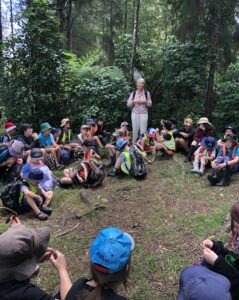
Principal, Michaela, models the values of caring, curiosity, community and sustainability.
Discussions across the Enviroschools network were being had on how we reflect – what was working well, what could be modified to facilitate the process more effectively. There was a variety of ways that the network was exploring to better align with the kaupapa and intentions of Enviroschools Holistic Reflection. There were examples of reflecting remotely/online during lockdowns and visits to Green-Gold reflections at East Tamaki Primary School in Tāmaki Makaurau/Auckland and at Toko School in Taranaki, both which provided inspiration for Waikato facilitators into the ways we could share and celebrate our schools’ successes and challenges.
At the start of the reflection process at Te Miro we asked the question: How can we make this work for the school, being truly student-led, maintaining integrity, in a relatively short period of time? Te Miro’s Principal, Michaela Phillips, and I met to create an overview and timeline. We booked a date to share, affirm and celebrate in early December, and worked backwards mapping out dates to work alongside students and staff in preparation and inviting guests for the sharing and celebration day.
Taking Action: Students leading the mahi
During the first reflection session with students, we unpacked the process, and we used the mirrors analogy activity to ask why we reflect – a fun way to start introducing a big concept and they immediately got it! The team read through the Enviroschools Green-Gold reflection statement and looked at the inspirational statements that explore what the journey could look like beyond Green-Gold. We asked, “which of these felt like their school?” These inspirational paragraphs resonated with the students, and they agreed Te Miro was at that stage. But how could this be shown? The Guiding Principles were reviewed, and on a large piece of paper students started recording all the things that they were proud of, aligned with the Enviroschools Guiding Principles and that made them a Green-Gold and beyond school. These ‘pride’ actions would be the basis for the school tour on the sharing day. Students chose the areas and actions that they were most proud of and took responsibility for how they would share this on the school tour.
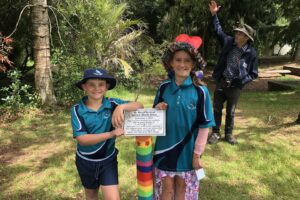
Current students share the story about how the school bush was established (see below for 2007 planting).
Nash shared about Ag Day; Ari and Sophie presented on the orchard and Kaitiakitanga; Elijah, Phillip and Leo took charge of the bike track and worms; Kate, Sophia and Adddison led the tour on the shade house, the bees and the water storage, and Evie and Isla led us around the small bush area and centenary garden. The whole student reflection team would then continue the tour down to the native bush area to share where weekly bush class takes place – learning about health and safety, biodiversity, setting trap lines and bush survival skills. The sharing and celebration day would end with a shared lunch in the bush with the whole school.
“I loved speaking about the school and sharing with visitors.” – student reflecting on the sharing and celebration day.
Over the next few student sessions, the photoshoot activity (p.259 ES kit) was used by students to capture evidence and a template for a slideshow 2023_ES_Waikato_TeMiroGuidingPrinciples.pptx was shared so students could create a visual presentation. The ‘Blue Arrow’ process (p.292 ES kit) was used to help them plan the sharing day, ending with a celebration shared lunch for the whole school in their local bush area.
At Te Miro School we have a deep feeling for our environment. Students are actively engaged in making decisions that have effects on our school, community and planet. We have the knowledge and confidence to think and act to create a sustainable future. Our school is connected with our surroundings and changes can be seen across all aspects of a sustainable community. These include changes to our local ecology, lifestyles, how decision-making is shared and how we interact and how culture is valued. Everyone makes decisions and takes actions that are good for people and nature. – Te Miro School statement
Holistic Change-making Connected Valuing each other and nature Empowered
Visionary Sustained Creative Courageous
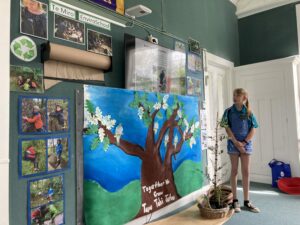
The oak and the kererū are important imagery for Te Miro students.
Students identified the big old oak tree in the playground as significant and painted a large replica tree to represent the reflection mahi. Oak leaves were used to record evidence, and acorns created to record Next Steps discussed over the weeks leading up to the sharing day and on the tour with the reflection team and visitors. Some great questions and deep thinking provided future focus. These included revisiting their waste reduction practices, creation of seasonal calendars, student pruning workshops in the orchard and further mahi on the bike track. The number of next steps was impressive – enthusiastic students and slightly concerned teachers, suggesting the need to prioritise and tackling a few ideas at a time!
“[I was] really excited to get some fruit pickers for the orchard because my grandma has one that works really well.” – student reflecting on one of the proposed next steps.
Reflecting on Change:
In the past, I have found that the decision-making part of the reflection days can often lack energy. Days can be big, discussions deep and the reflection team is often running low on steam by the end of the day. The biggest change we made with Te Miro’s sharing day was deciding to have a ‘sharing and celebration’ day. The focus was on highlighting actions and changes in the school, gathering Next Steps during discussions on the school tour and then celebrating and finishing the day lunch at 12.30pm. The ‘decision’ part of the reflection had already taken place with the student team as part of initial building understanding of the reflection process. Students unpacked the beyond Green-Gold sentences and explored ‘evidence’ aligning with the Guiding Principles that confirmed that they were a Green-Gold Enviroschool and beyond. This removed some pressure during the sharing day, with no surprises nor uncertainty and created a real atmosphere of excitement. It also meant that the celebration and gathering ideas for moving forward could be the key focus of the day.
“I loved talking about the bush and the work we do, how we plant trees there and the celebrations we do there.” – student reflection
Another point of difference was how we found evidence of actions and the Guiding Principles within school life. Students looked for what made them proud of Te Miro and what they wanted to share. We also found that the school is really good at sharing digitally with their community, so going through Facebook posts became another useful tool to record the journey. It was a great way to have mahi recorded, and changes could be identified over time.
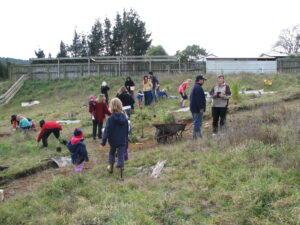
The community planting day in what was once the horse paddock at Te Miro School in 2007 before their last Enviroschools Holistic Reflection.

Students stand in the bush that has been added to and cared for over the last 15 years. (Compare with image on left).
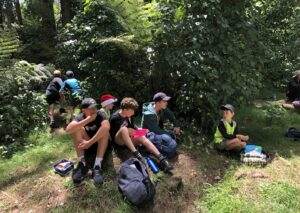
Out and about in the local environment – learning in the bush on the neighbouring property.